Unveiling Microbial Diversity in Greek Urban Air and Recreational Seawater Using DNA Barcoding
Abstract
1. Introduction
2. Materials and Methods
2.1. Air Sampling
2.2. Water Sampling
2.3. Sample Elution and Extraction
2.4. DNA Barcoded Amplicon Sequencing Analysis
2.5. Data Analysis
3. Results
3.1. Sampling Time, Sites, and Conditions
3.2. Microbiome Taxonomy, Richness, and Abundance
3.2.1. Air
3.2.2. Coastal Waters
3.2.3. Spearman’s Rank Correlations (Spearman’s Rho)
4. Discussion
4.1. Marine Microbiome Diversity and Public Health Relevance
4.2. Airborne Microbiome and Public Health Relevance
4.3. Shared Taxa Across Ecosystems
4.4. Environmental and Meteorological Influences
5. Conclusions
Supplementary Materials
Author Contributions
Funding
Institutional Review Board Statement
Informed Consent Statement
Data Availability Statements
Acknowledgments
Conflicts of Interest
References
- Brągoszewska, E.; Mainka, A. Bacterial Aerosol in Ambient Air—A Review Study. Appl. Sci. 2024, 14, 8250. [Google Scholar] [CrossRef]
- Bacteria and Fungi in the Sea. In The Biology of Marine Plants; Dring, M.J., Ed.; Cambridge University Press: Cambridge, UK, 1991; pp. 170–177. ISBN 978-0-521-42765-4. [Google Scholar]
- Peng, X.; Amend, A.S.; Baltar, F.; Blanco-Bercial, L.; Breyer, E.; Burgaud, G.; Cunliffe, M.; Edgcomb, V.P.; Grossart, H.-P.; Mara, P.; et al. Planktonic Marine Fungi: A Review. ESS Open Arch. 2023. [Google Scholar] [CrossRef]
- Hassett, B.T.; Vonnahme, T.R.; Peng, X.; Jones, E.B.G.; Heuzé, C. Global Diversity and Geography of Planktonic Marine Fungi. Bot. Mar. 2020, 63, 121–139. [Google Scholar] [CrossRef]
- Peng, X.; Amend, A.S.; Baltar, F.; Blanco-Bercial, L.; Breyer, E.; Burgaud, G.; Cunliffe, M.; Edgcomb, V.P.; Grossart, H.-P.; Mara, P.; et al. Planktonic Marine Fungi: A Review. J. Geophys. Res. Biogeosci. 2024, 129, e2023JG007887. [Google Scholar] [CrossRef]
- Maki, T.; Lee, K.C.; Pointing, S.B.; Watanabe, K.; Aoki, K.; Archer, S.D.J.; Lacap-Bugler, D.C.; Ishikawa, A. Desert and Anthropogenic Mixing Dust Deposition Influences Microbial Communities in Surface Waters of the Western Pacific Ocean. Sci. Total Environ. 2021, 791, 148026. [Google Scholar] [CrossRef] [PubMed]
- Belkin, S.; Colwell, R.R. (Eds.) Oceans and Health: Pathogens in the Marine Environment; Springer Science + Business Media: New York, NY, USA, 2006; ISBN 978-0-387-23708-4. [Google Scholar]
- Arvanitidou, M.; Kanellou, K.; Katsouyannopoulos, V.; Tsakris, A. Occurrence and Densities of Fungi from Northern Greek Coastal Bathing Waters and Their Relation with Faecal Pollution Indicators. Water Res. 2002, 36, 5127–5131. [Google Scholar] [CrossRef] [PubMed]
- Papadakis, J.A.; Mavridou, A.; Richardson, S.C.; Lampiri, M.; Marcelou, U. Bather-Related Microbial and Yeast Populations in Sand and Seawater. Water Res. 1997, 31, 799–804. [Google Scholar] [CrossRef]
- Huang, Z.; Yu, X.; Liu, Q.; Maki, T.; Alam, K.; Wang, Y.; Xue, F.; Tang, S.; Du, P.; Dong, Q.; et al. Bioaerosols in the Atmosphere: A Comprehensive Review on Detection Methods, Concentration and Influencing Factors. Sci. Total Environ. 2024, 912, 168818. [Google Scholar] [CrossRef]
- Olson, Z.H.; Briggler, J.T.; Williams, R.N. An eDNA Approach to Detect Eastern Hellbenders (Cryptobranchus a. alleganiensis) Using Samples of Water. Wildl. Res. 2012, 39, 629–636. [Google Scholar] [CrossRef]
- Grydaki, N.; Colbeck, I.; Mendes, L.; Eleftheriadis, K.; Whitby, C. Bioaerosols in the Athens Metro: Metagenetic Insights into the PM10 Microbiome in a Naturally Ventilated Subway Station. Environ. Int. 2021, 146, 106186. [Google Scholar] [CrossRef]
- Cristescu, M.E. From Barcoding Single Individuals to Metabarcoding Biological Communities: Towards an Integrative Approach to the Study of Global Biodiversity. Trends Ecol. Evol. 2014, 29, 566–571. [Google Scholar] [CrossRef]
- Ruppert, K.M.; Kline, R.J.; Rahman, M.S. Past, Present, and Future Perspectives of Environmental DNA (eDNA) Metabarcoding: A Systematic Review in Methods, Monitoring, and Applications of Global eDNA. Glob. Ecol. Conserv. 2019, 17, e00547. [Google Scholar] [CrossRef]
- Tzafesta, E.; Saccomanno, B.; Zangaro, F.; Vadrucci, M.R.; Specchia, V.; Pinna, M. DNA Barcode Gap Analysis for Multiple Marker Genes for Phytoplankton Species Biodiversity in Mediterranean Aquatic Ecosystems. Biology 2022, 11, 1277. [Google Scholar] [CrossRef]
- Liang, X.; Yang, X.; Sha, N.; Wang, J.; Qiu, G.; Chang, M. Application of eDNA Metabarcoding Technology to Monitor the Health of Aquatic Ecosystems. Water 2025, 17, 1109. [Google Scholar] [CrossRef]
- Metaxatos, A.; Georgiadou, D.; Hatzinikolaou, D.; Mainelis, G. The Diversity, Richness, and Potential Health and Ecological Role of the Fungal Aerosols in Attica, Greece. Aerosol Air Qual. Res. 2024, 24, 240170. [Google Scholar] [CrossRef]
- Metaxatos, A.; Manibusan, S.; Mainelis, G. Investigation of Sources, Diversity, and Variability of Bacterial Aerosols in Athens, Greece: A Pilot Study. Atmosphere 2022, 13, 45. [Google Scholar] [CrossRef]
- Therkorn, J.; Thomas, N.; Calderón, L.; Scheinbeim, J.; Mainelis, G. Design and Development of a Passive Bioaerosol Sampler Using Polarized Ferroelectric Polymer Film. J. Aerosol Sci. 2017, 105, 128–144. [Google Scholar] [CrossRef]
- Grogan, S.N.C.M.; Mainelis, G. Effect of Sampling Duration on Culturable and Viable Bioaerosol Determination When Using Rutgers Electrostatic Passive Sampler (REPS). J. Aerosol Sci. 2022, 166, 106066. [Google Scholar] [CrossRef]
- Grogan, S.N.C.M.; Han, T.T.; Mainelis, G. Development and Initial Testing of an Active Low-Power, Ferroelectric Film-Based Bioaerosol Sampler. Aerosol Sci. Technol. 2022, 56, 1132–1145. [Google Scholar] [CrossRef] [PubMed]
- Friligos, N.; Gotsis-Skretas, O. Relationships of Phytoplankton with Certain Environmental Factors in the South Euboikos Gulf (Greece). Mar. Ecol. 1987, 8, 59–73. [Google Scholar] [CrossRef]
- Metaxatos, A. Population Dynamics of the Venerid Bivalve Callista chione (L.) in a Coastal Area of the Eastern Mediterranean. J. Sea Res. 2004, 52, 293–305. [Google Scholar] [CrossRef]
- Ushio, M.; Furukawa, S.; Murakami, H.; Masuda, R.; Nagano, A.J. An Efficient Early-Pooling Protocol for Environmental DNA Metabarcoding. Environ. DNA 2022, 4, 1212–1228. [Google Scholar] [CrossRef]
- Hassan, S.; Sabreena; Poczai, P.; Ganai, B.A.; Almalki, W.H.; Gafur, A.; Sayyed, R.Z. Environmental DNA Metabarcoding: A Novel Contrivance for Documenting Terrestrial Biodiversity. Biology 2022, 11, 1297. [Google Scholar] [CrossRef] [PubMed]
- Amend, A.; Burgaud, G.; Cunliffe, M.; Edgcomb, V.P.; Ettinger, C.L.; Gutiérrez, M.H.; Heitman, J.; Hom, E.F.Y.; Ianiri, G.; Jones, A.C.; et al. Fungi in the Marine Environment: Open Questions and Unsolved Problems. mBio 2019, 10, 10–1128. [Google Scholar] [CrossRef]
- Frohlich-Nowoisky, J.; Burrows, S.M.; Xie, Z.; Engling, G.; Solomon, P.A.; Fraser, M.P.; Mayol-Bracero, O.L.; Artaxo, P.; Begerow, D.; Conrad, R.; et al. Biogeography in the Air: Fungal Diversity over Land and Oceans. Biogeosciences 2012, 9, 1125–1136. [Google Scholar] [CrossRef]
- Jones, E.G.; Devadatha, B.; Abdel-Wahab, M.A.; Dayarathne, M.C.; Zhang, S.N.; Hyde, K.D.; Liu, J.-K.; Bahkali, A.H.; Sarma, V.V.; Tibell, S.; et al. Phylogeny of New Marine Dothideomycetes and Sordariomycetes from Mangroves and Deep-Sea Sediments. Bot. Mar. 2020, 63, 155–181. [Google Scholar] [CrossRef]
- Tennakoon, D.; Thambugala, K.; de Silva, N.; Suwannarach, N.; Lumyong, S. A Taxonomic Assessment of Novel and Remarkable Fungal Species in Didymosphaeriaceae (Pleosporales, Dothideomycetes) from Plant Litter. Front. Microbiol. 2022, 13, 1016285. [Google Scholar] [CrossRef]
- Jones, E.B.G. Fifty Years of Marine Mycology. Fungal Divers. 2011, 50, 73–112. [Google Scholar] [CrossRef]
- Chen, J.; Jia, Y.; Sun, Y.; Liu, K.; Zhou, C.; Liu, C.; Li, D.; Liu, G.; Zhang, C.; Yang, T.; et al. Global Marine Microbial Diversity and Its Potential in Bioprospecting. Nature 2024, 633, 371–379. [Google Scholar] [CrossRef]
- El-Malah, S.S.; Rasool, K.; Jabbar, K.A.; Sohail, M.U.; Baalousha, H.M.; Mahmoud, K.A. Marine Bacterial Community Structures of Selected Coastal Seawater and Sediment Sites in Qatar. Microorganisms 2023, 11, 2827. [Google Scholar] [CrossRef]
- Akinnawo, S.O. Eutrophication: Causes, Consequences, Physical, Chemical and Biological Techniques for Mitigation Strategies. Environ. Chall. 2023, 12, 100733. [Google Scholar] [CrossRef]
- Jessen, C.; Bednarz, V.; Rix, L.; Teichberg, M.; Wild, C. Marine Eutrophication. In Environmental Indicators; Springer: Dordrecht, The Netherlands, 2015; p. 27. ISBN 978-94-017-9498-5. [Google Scholar]
- Ignatiades, L.; Gotsis-Skretas, O. A Review on Toxic and Harmful Algae in Greek Coastal Waters (E. Mediterranean Sea). Toxins 2010, 2, 1019–1037. [Google Scholar] [CrossRef] [PubMed]
- Genitsaris, S. Review of Harmful Algal Blooms in the Coastal Mediterranean Sea, with a Focus on Greek Waters. Diversity 2021, 13, 396. [Google Scholar] [CrossRef]
- Marine Species of the British Isles and Adjacent Seas (MSBIAS)—Cryptophyta. Available online: https://www.marinespecies.org/Msbias/aphia.php?p=taxdetails&id=17638 (accessed on 24 July 2025).
- Gonzalez-Martin, C. Airborne Infectious Microorganisms. Encycl. Microbiol. 2019, 52, 52–60. [Google Scholar] [CrossRef]
- Liu, G.; Tang, C.M.; Exley, R.M. Non-Pathogenic Neisseria: Members of an Abundant, Multi-Habitat, Diverse Genus. Microbiology 2015, 161, 1297–1312. [Google Scholar] [CrossRef]
- Romalde, J.L.; Dieguez, A.L.; Lasa, A.; Balboa, S. New Vibrio Species Associated to Molluscan Microbiota: A Review. Front. Microbiol. 2014, 4, 413. [Google Scholar] [CrossRef]
- Zhong, X.; Qi, J.; Li, H.; Dong, L.; Gao, D. Seasonal Distribution of Microbial Activity in Bioaerosols in the Outdoor Environment of the Qingdao Coastal Region. Atmos. Environ. 2016, 140, 506–513. [Google Scholar] [CrossRef]
- Adhikari, A.; Reponen, T.; Grinshpun, S.A.; Martuzevicius, D.; LeMasters, G. Correlation of Ambient Inhalable Bioaerosols with Particulate Matter and Ozone: A Two-Year Study. Environ. Pollut. 2006, 140, 16–28. [Google Scholar] [CrossRef]
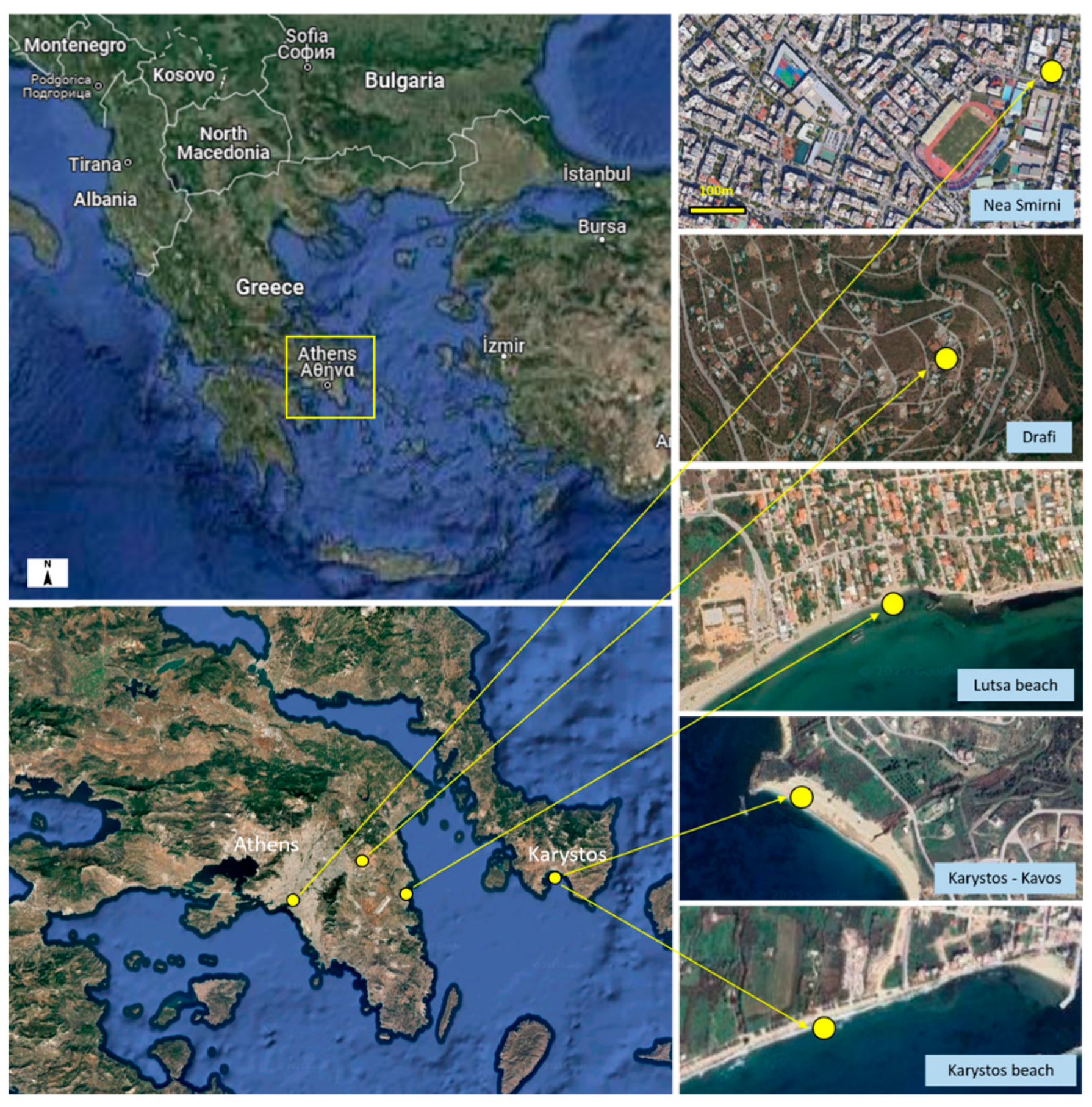
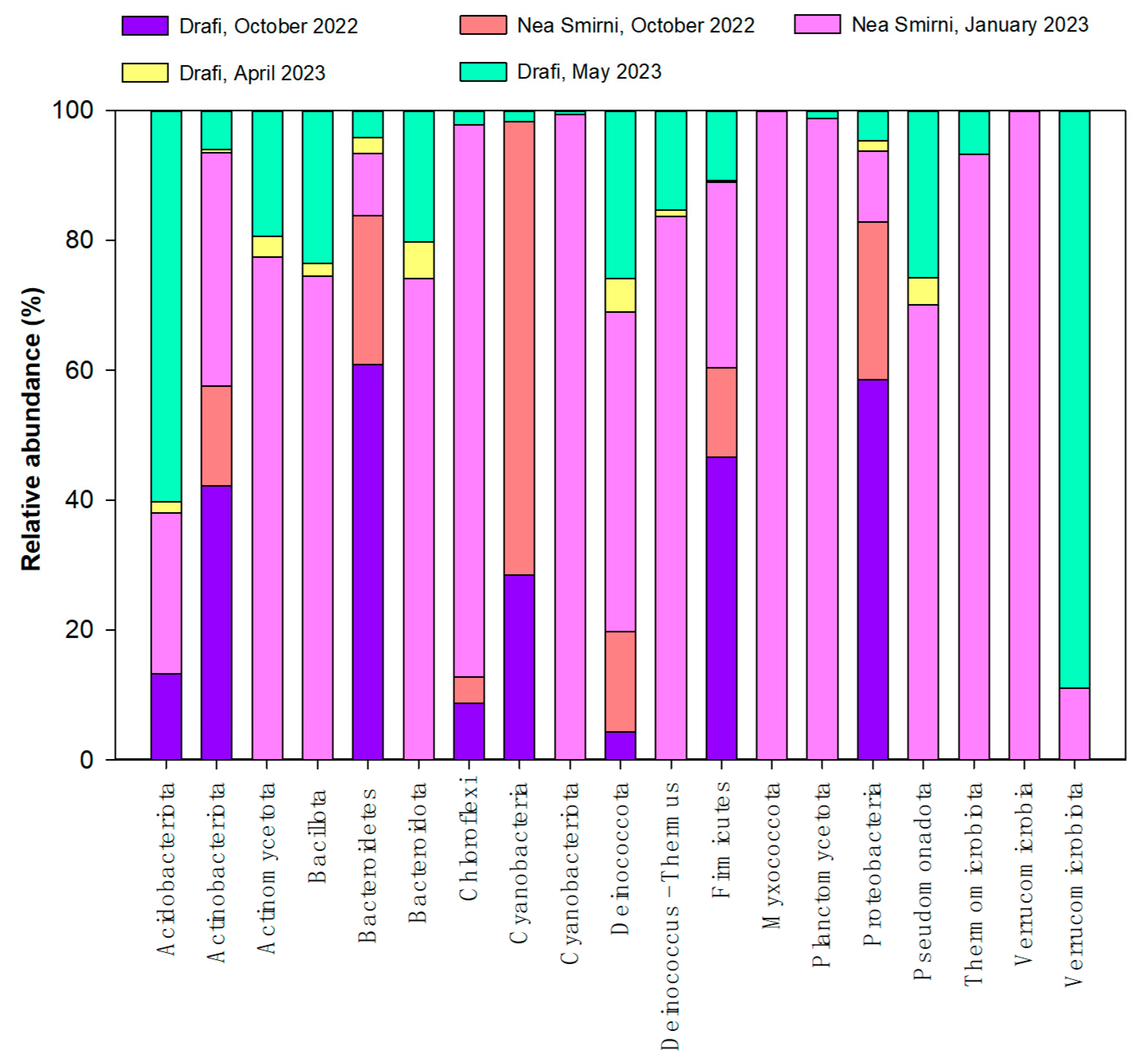
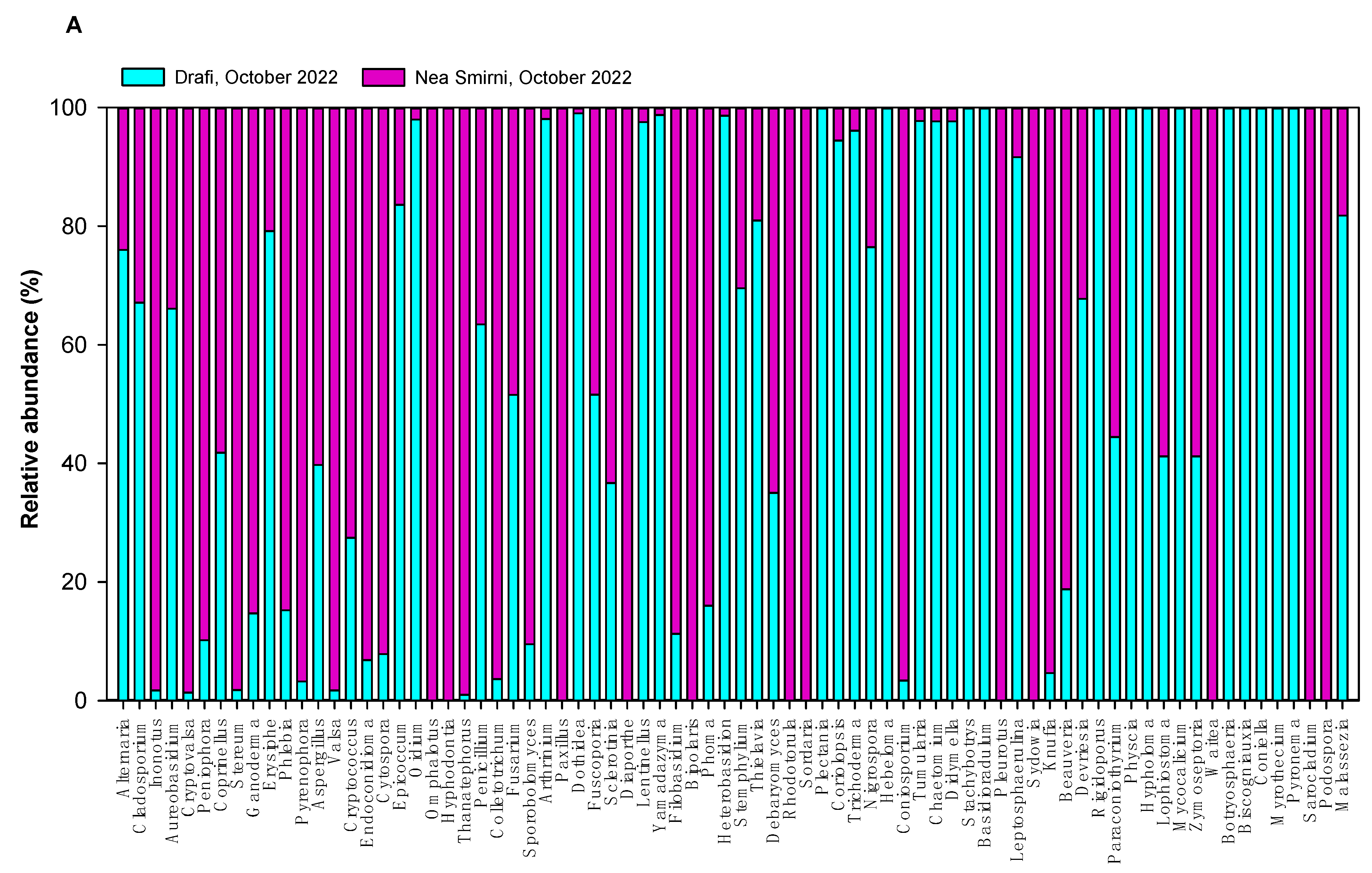
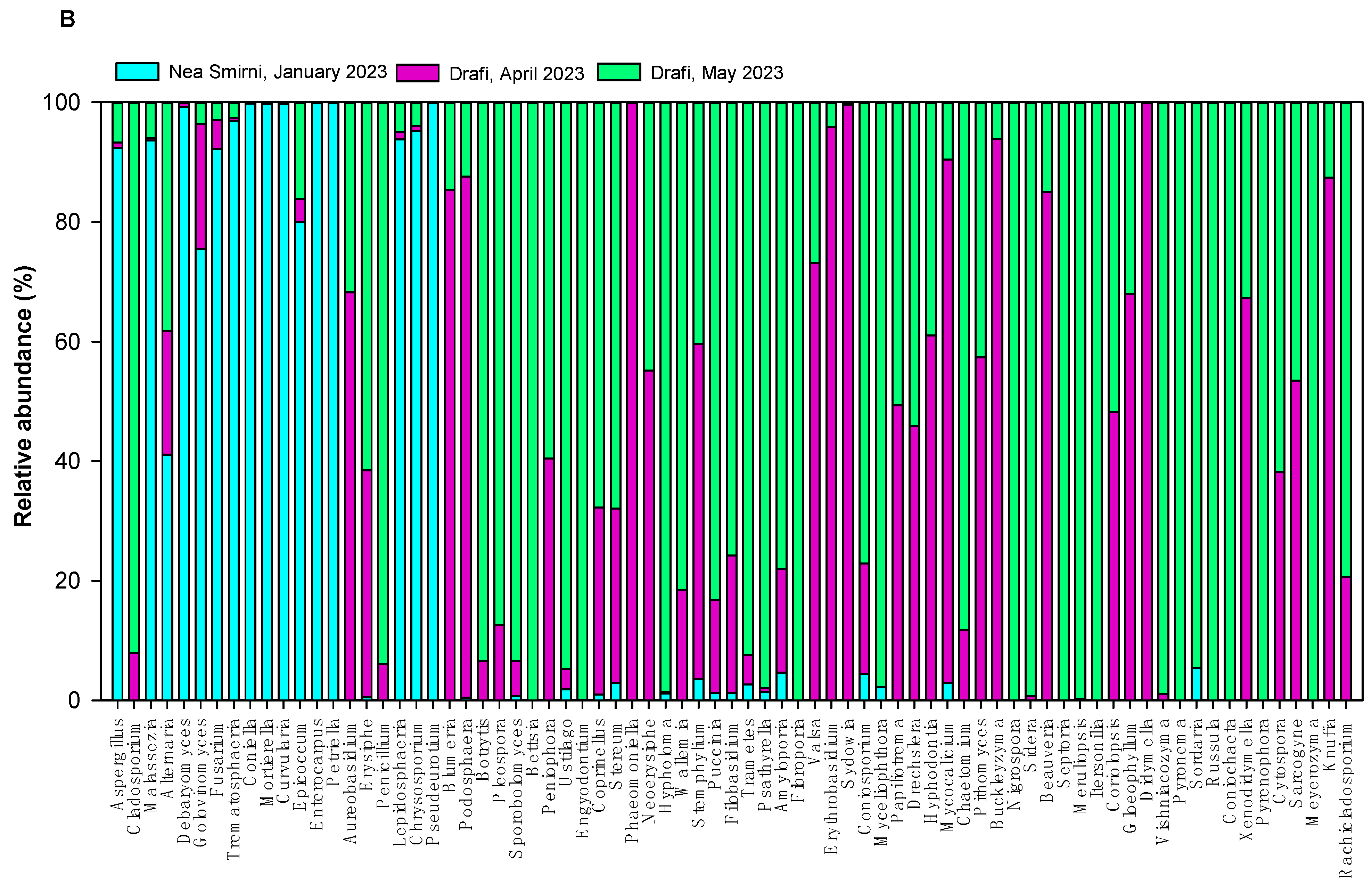
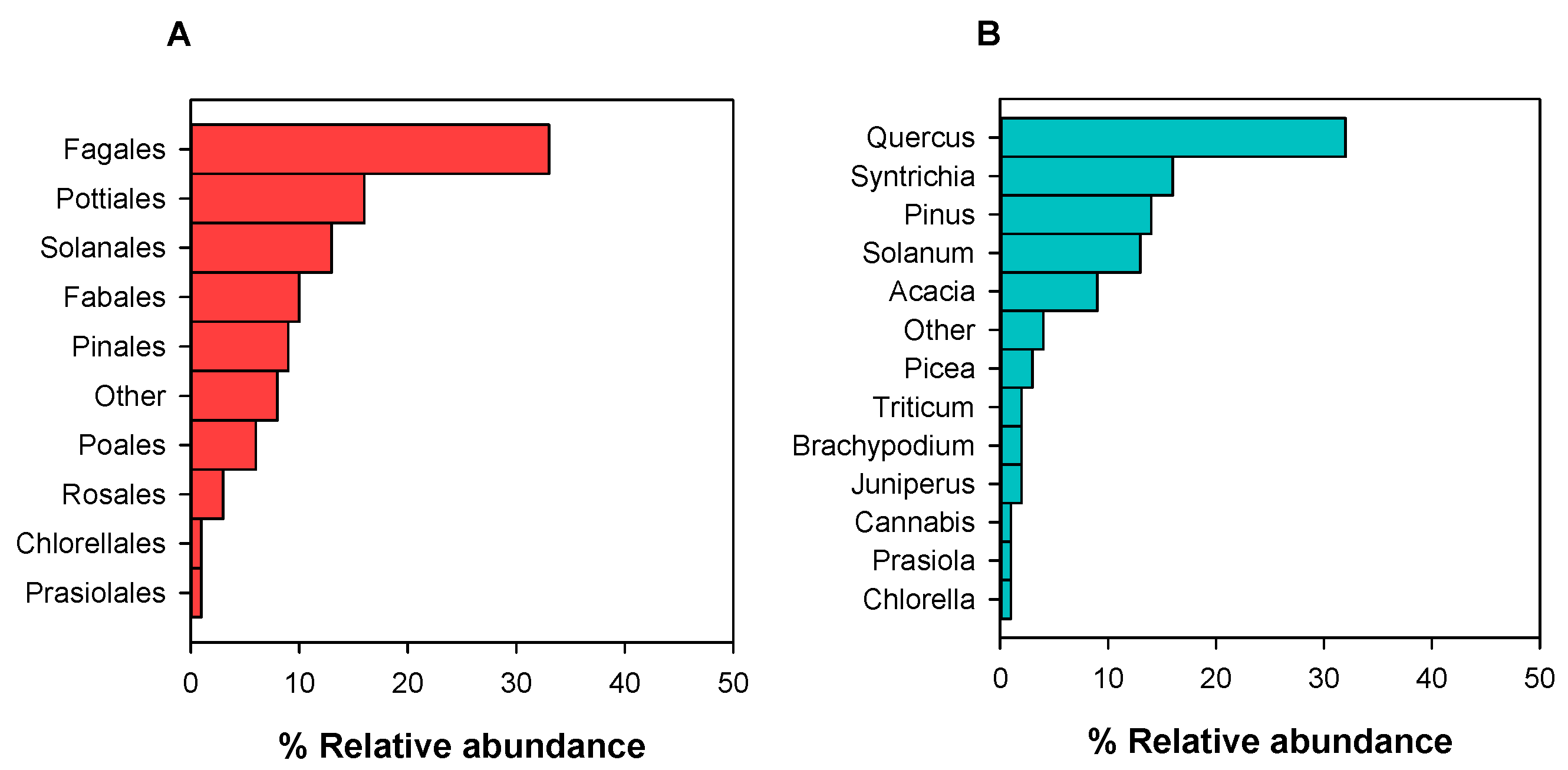
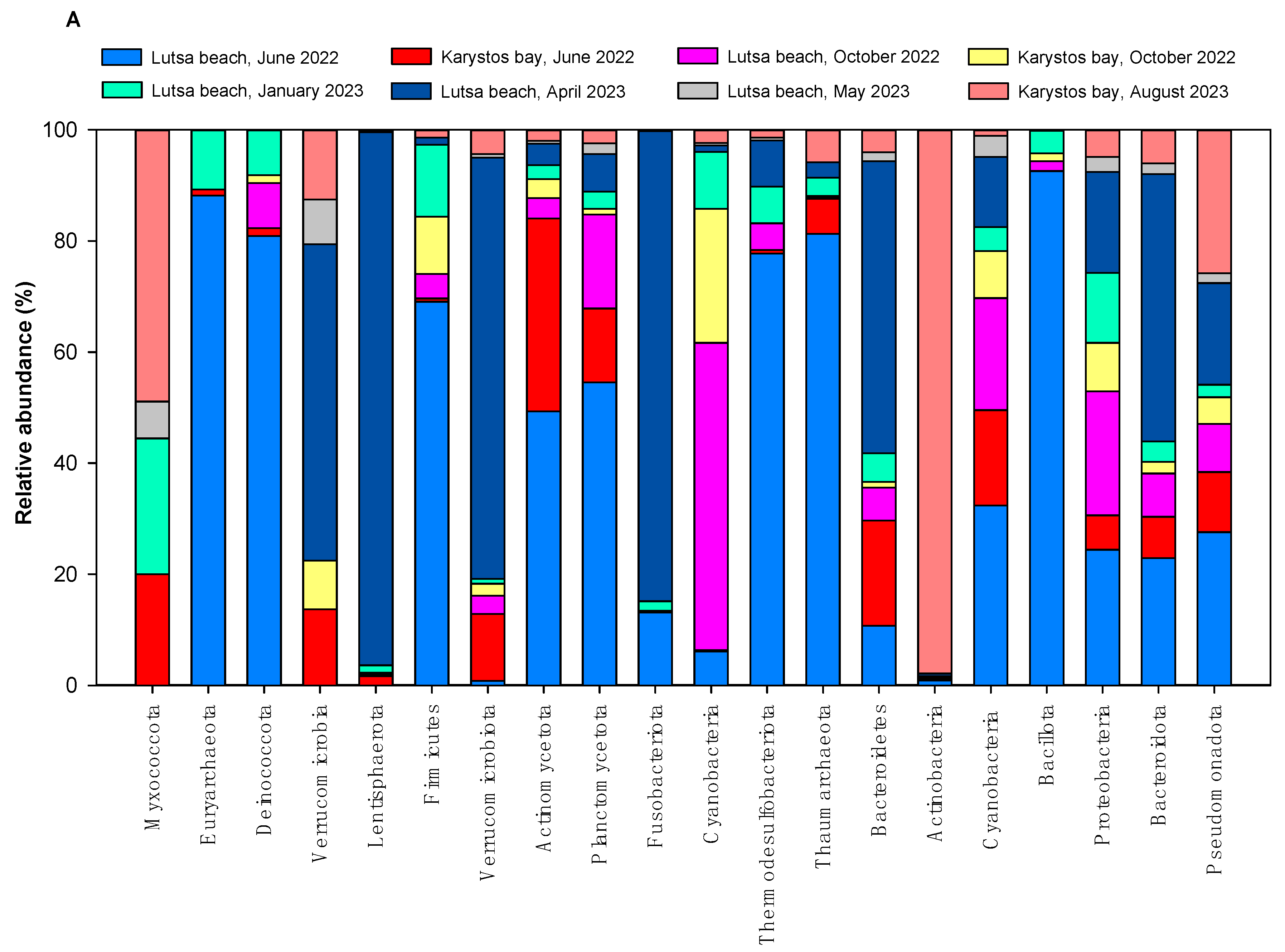
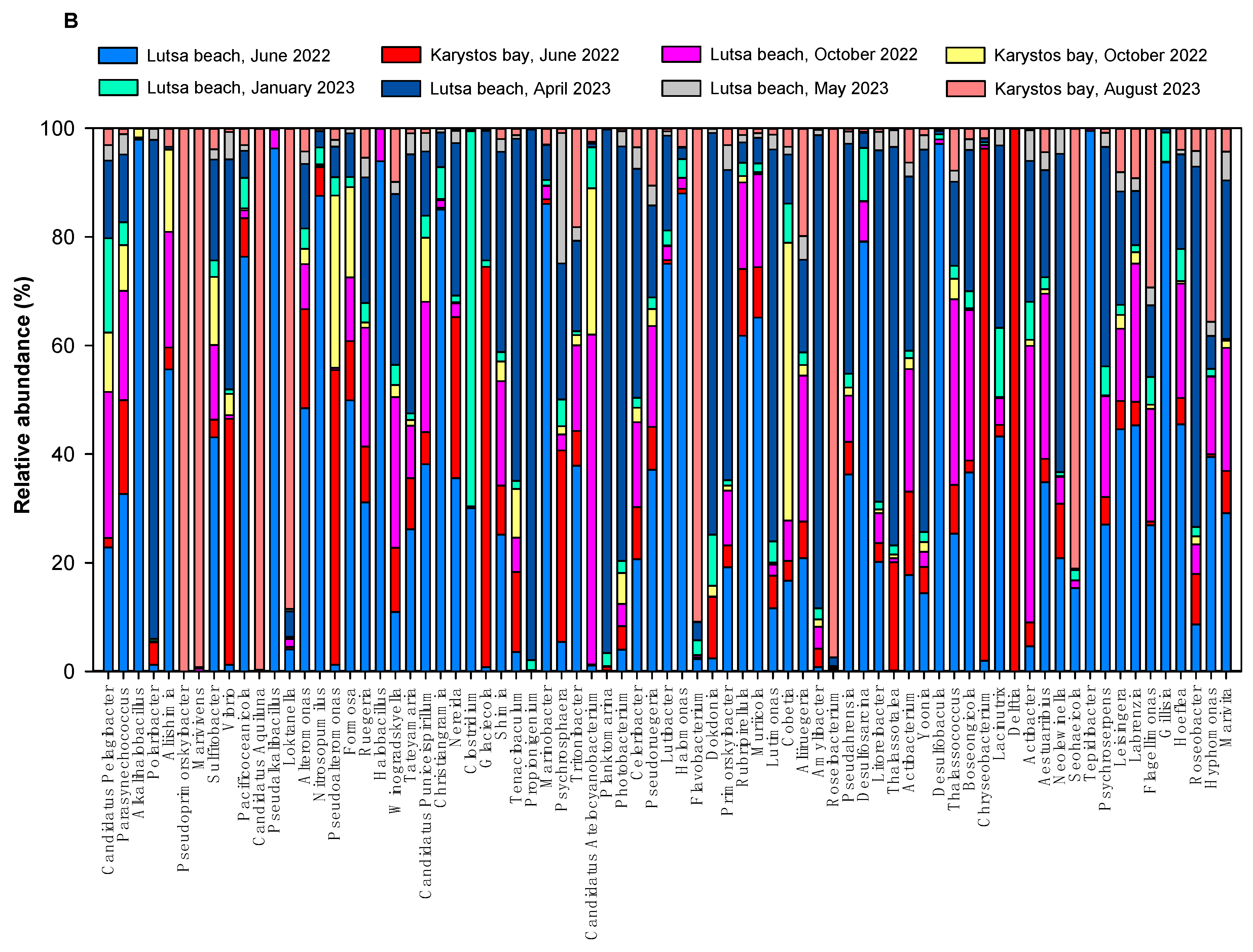
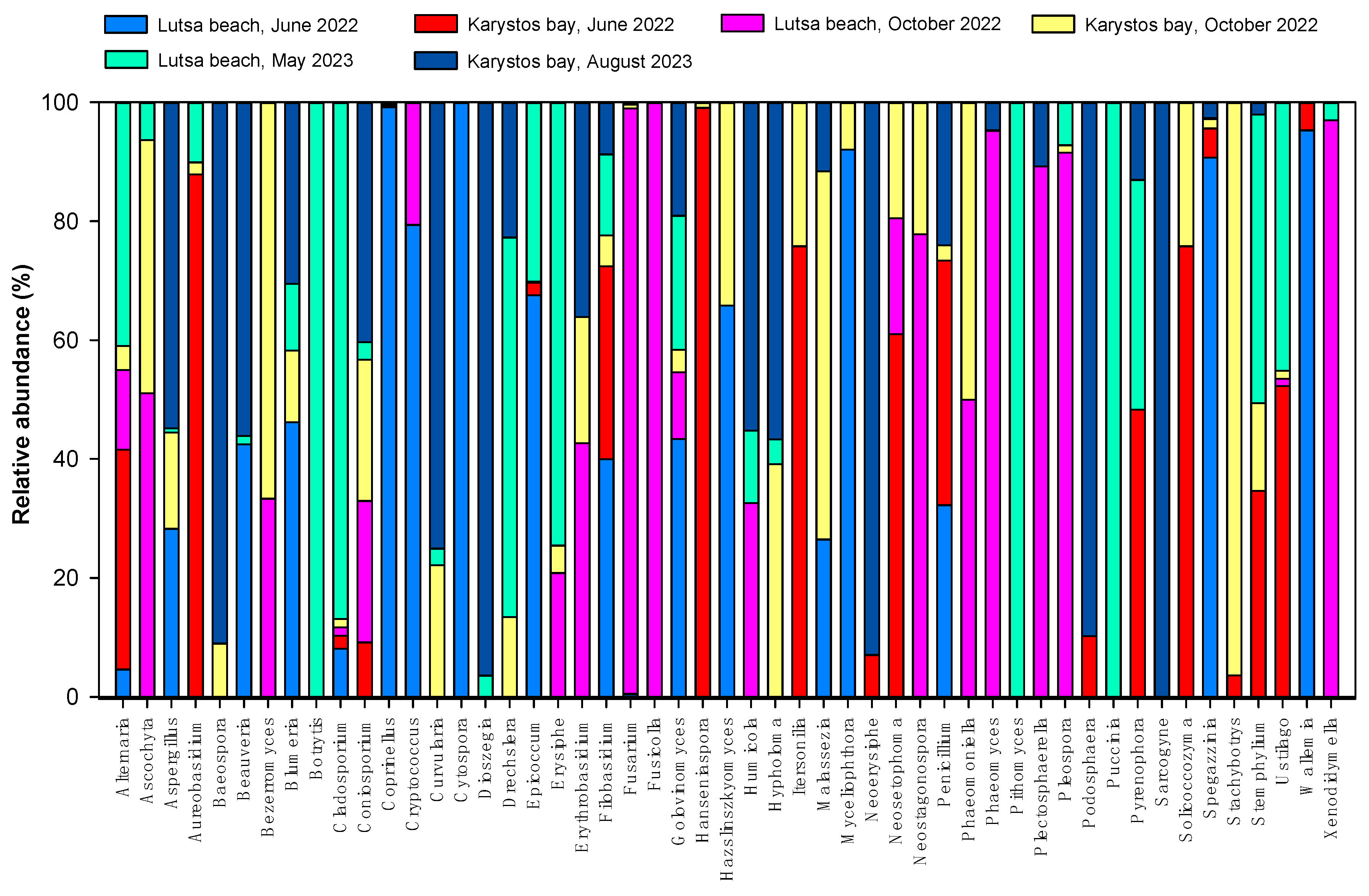

| Sample | Location | Sampling Period | Air Sampler | Rain (mm) | Wind Speed (WS) (km/h) | High Wind Speed (km/h) | Wind Direction | T (oC) | High T (oC) | PM10 (μg/m3) | Bacterial Richness (Genera) | Bacterial Abundance, zOTU/m3 | Fungal Richness (Genera) | Fungal Abundance, zOTU/m3 |
|---|---|---|---|---|---|---|---|---|---|---|---|---|---|---|
| 1 | Drafi | 3-9/10/2022 | Button, x2 | 0.0 | 8.3 | 33.6 | NE | 20.5 | 24.1 | 20.7 | 193 | 1372 | 66 | 2193 |
| 2 | Drafi | 3-9/10/2022 | REPS. x3 | 0.0 | 8.3 | 33.6 | NE | 20.5 | 24.1 | 20.7 | 226 | 7275 | ||
| 3 | Drafi | 3-9/10/2022 | aREPS. x2 | 0.0 | 8.3 | 33.6 | NE | 20.5 | 24.1 | 20.7 | 225 | 8609 | 58 | 3270 |
| 4 | N. Smirni | 10-15/10/2022 | Button. x2 | 1.2 | 5.0 | 40.2 | ΝΝW | 20.5 | 23.9 | 24.0 | 188 | 4018 | 65 | 6143 |
| 5 | N. Smirni | 10-15/10/2022 | aREPS. x2 | 1.2 | 5.0 | 40.2 | ΝΝW | 20.5 | 23.9 | 24.0 | 196 | 2432 | 13 | 2170 |
| 6 | N. Smirni | 10-15/10/2022 | REPS. x3 | 1.2 | 5.0 | 40.2 | ΝΝW | 20.5 | 23.9 | 24.0 | 176 | 3322 | ||
| 7 | N. Smirni | 10-15/10/2022 | FS. x3 | 1.2 | 5.0 | 40.2 | ΝΝW | 20.5 | 23.9 | 24.0 | 209 | 674 | 30 | 1500 |
| 8 | N. Smirni | 13-19/1/2023 | REPS. x3 | 0.0 | 1.9 | 10.6 | SSE | 14.2 | 16.9 | 35.7 | 218 | 517 | 45 | 558 |
| 9 | N. Smirni | 13-19/1/2023 | Button. x2 | 0.0 | 1.9 | 10.6 | SSE | 14.2 | 16.9 | 35.7 | 130 | 718 | ||
| 10 | N. Smirni | 13-19/1/2023 | FS. x3 | 0.0 | 1.9 | 10.6 | SSE | 14.2 | 16.9 | 35.7 | 69 | 158 | 39 | 182 |
| 11 | Drafi | 23/3-7/4/2023 | REPS. x3 | 1.8 | 2.3 | 12.7 | NW | 13.5 | 18.1 | 35.0 | 167 | 34 | 66 | 260 |
| 12 | Drafi | 23/3-7/4/2023 | FS. x3 | 1.8 | 2.3 | 12.7 | NW | 13.5 | 18.1 | 35.0 | 68 | 12 | 40 | 45 |
| 13 | Drafi | 10-19/5/2023 | FS | 0.2 | 5.0 | 21.5 | ENE | 17.6 | 21.6 | 26.1 | 94 | 198 | ||
| 14 | Drafi | 10-19/5/2023 | FS | 0.2 | 5.0 | 21.5 | ENE | 17.6 | 21.6 | 26.1 | 169 | 129 | 54 | 333 |
| 15 | Drafi | 10-19/5/2023 | FS | 0.2 | 5.0 | 21.5 | ENE | 17.6 | 21.6 | 26.1 | 162 | 35 | 79 | 449 |
| Sampling | Place | Day | Sampling Name | Bacteria Richness. Genera | Bacterial Abundance. zOTU/L | Samples (Fungi) | Fungal Richness. Genera | Fungal Abundance. zOTU/L |
|---|---|---|---|---|---|---|---|---|
| 1 | Karystos | 1/6/2022 | KJn2022 | 192 | 12,489 | pool 1 (KkJn2022 + KJn2022) | 21 | 5861 |
| 3 | Karystos-Kavos | 21/6/2022 | KkJn2022 | 319 | 16,497 | |||
| 2 | Lutsa | 20/6/2022 | LJn2022 | 323 | 56,902 | LJn2022 | 18 | 1231 |
| 4 | Lutsa | 9/10/2022 | LOct2022 | 322 | 17,203 | LOct2022 | 20 | 3686 |
| 5 | Karystos-Kavos | 12/10/2022 | KkOct2022 | 222 | 7445 | pool 2 (KkOct2022 + KOct2022) | 34 | 281 |
| 6 | Karystos | 12/10/2022 | KOct2022 | 157 | 8145 | |||
| 7 | Lutsa | 20/1/2023 | LJan2023 | 343 | 7130 | |||
| 8 | Lutsa | 6/4/2023 | LApr2023 | 253 | 34,582 | |||
| 9 | Lutsa | 18/5/2023 | LMay2023 | 281 | 3157 | LMay2023 | 28 | 1333 |
| 11 | Karystos | 29/8/2023 | KAug2023 | 171 | 49,717 | Pool 3 (KkAug2023 + KAug2023) | 24 | 369 |
| 12 | Karystos-Kavos | 29/8/2023 | KkAug2023 | 239 | 4383 |
| Bacterial Abundance | Bacterial Richness | Fungal Abundance | Fungal Richness | PM10 | Rain | Temperature | Wind Speed (WS) | ||
|---|---|---|---|---|---|---|---|---|---|
| Bacterial Abundance | Correlation Coefficient | 1.000 | 0.718 ** | 0.918 ** | −0.137 | −0.709 ** | −0.361 | 0.819 ** | 0.587 * |
| Sig. (2-tailed) | 0.003 | 0.000 | 0.689 | 0.003 | 0.186 | 0.000 | 0.021 | ||
| N | 15 | 15 | 11 | 11 | 15 | 15 | 15 | 15 | |
| Bacterial Richness | Correlation Coefficient | 0.718 ** | 1.000 | 0.745 ** | −0.159 | −0.658 ** | −0.283 | 0.682 ** | 0.572 * |
| Sig. (2-tailed) | 0.003 | 0.008 | 0.640 | 0.008 | 0.308 | 0.005 | 0.026 | ||
| N | 15 | 15 | 11 | 11 | 15 | 15 | 15 | 15 | |
| Fungal Abundance | Correlation Coefficient | 0.918 ** | 0.745 ** | 1.000 | 0.155 | −0.806 ** | −0.274 | 0.889 ** | 0.716 * |
| Sig. (2-tailed) | 0.000 | 0.008 | 0.649 | 0.003 | 0.415 | 0.000 | 0.013 | ||
| N | 11 | 11 | 11 | 11 | 11 | 11 | 11 | 11 | |
| Fungal Richness | Correlation Coefficient | −0.137 | −0.159 | 0.155 | 1.000 | −0.167 | −0.109 | −0.065 | 0.313 |
| Sig. (2-tailed) | 0.689 | 0.640 | 0.649 | 0.623 | 0.750 | 0.849 | 0.349 | ||
| N | 11 | 11 | 11 | 11 | 11 | 11 | 11 | 11 | |
| PM10 | Correlation Coefficient | −0.709 ** | −0.658 ** | −0.806 ** | −0.167 | 1.000 | 0.040 | −0.902 ** | −0.960 ** |
| Sig. (2-tailed) | 0.003 | 0.008 | 0.003 | 0.623 | 0.887 | 0.000 | 0.000 | ||
| N | 15 | 15 | 11 | 11 | 15 | 15 | 15 | 15 | |
| Rain | Correlation Coefficient | −0.361 | −0.283 | −0.274 | −0.109 | 0.040 | 1.000 | −0.113 | −0.125 |
| Sig. (2-tailed) | 0.186 | 0.308 | 0.415 | 0.750 | 0.887 | . | 0.687 | 0.656 | |
| N | 15 | 15 | 11 | 11 | 15 | 15 | 15 | 15 | |
| Temperature | Correlation Coefficient | 0.819 ** | 0.682 ** | 0.889 ** | −0.065 | −0.902 ** | −0.113 | 1.000 | 0.818 ** |
| Sig. (2-tailed) | 0.000 | 0.005 | 0.000 | 0.849 | 0.000 | 0.687 | 0.000 | ||
| N | 15 | 15 | 11 | 11 | 15 | 15 | 15 | 15 | |
| Wind speed (WS) | Correlation Coefficient | 0.587 * | 0.572 * | 0.716 * | 0.313 | −0.960 ** | −0.125 | 0.818 ** | 1.000 |
| Sig. (2-tailed) | 0.021 | 0.026 | 0.013 | 0.349 | 0.000 | 0.656 | 0.000 | ||
| N | 15 | 15 | 11 | 11 | 15 | 15 | 15 | 15 | |
Disclaimer/Publisher’s Note: The statements, opinions and data contained in all publications are solely those of the individual author(s) and contributor(s) and not of MDPI and/or the editor(s). MDPI and/or the editor(s) disclaim responsibility for any injury to people or property resulting from any ideas, methods, instructions or products referred to in the content. |
© 2025 by the authors. Licensee MDPI, Basel, Switzerland. This article is an open access article distributed under the terms and conditions of the Creative Commons Attribution (CC BY) license (https://creativecommons.org/licenses/by/4.0/).
Share and Cite
Metaxatos, A.; Georgiadou, D.; Hatzinikolaou, D.G.; Mainelis, G. Unveiling Microbial Diversity in Greek Urban Air and Recreational Seawater Using DNA Barcoding. Atmosphere 2025, 16, 1082. https://doi.org/10.3390/atmos16091082
Metaxatos A, Georgiadou D, Hatzinikolaou DG, Mainelis G. Unveiling Microbial Diversity in Greek Urban Air and Recreational Seawater Using DNA Barcoding. Atmosphere. 2025; 16(9):1082. https://doi.org/10.3390/atmos16091082
Chicago/Turabian StyleMetaxatos, Angelina, Dafni Georgiadou, Dimitris G. Hatzinikolaou, and Gediminas Mainelis. 2025. "Unveiling Microbial Diversity in Greek Urban Air and Recreational Seawater Using DNA Barcoding" Atmosphere 16, no. 9: 1082. https://doi.org/10.3390/atmos16091082
APA StyleMetaxatos, A., Georgiadou, D., Hatzinikolaou, D. G., & Mainelis, G. (2025). Unveiling Microbial Diversity in Greek Urban Air and Recreational Seawater Using DNA Barcoding. Atmosphere, 16(9), 1082. https://doi.org/10.3390/atmos16091082








